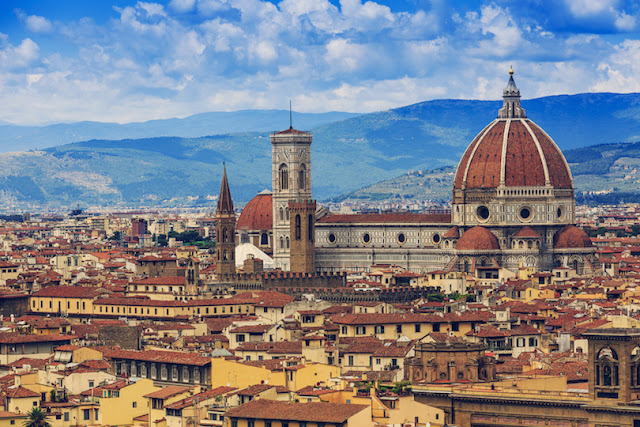Top Tourist Attractions in Florence
10 Top Tourist Attractions in Florence
The capital of Tuscany, Florence is often described as a colossal
outdoor museum because of its mass of art and architectural treasures.
Internationally observed as the birthplace of Italian Renaissance, Florence is
also credited with propagating many artists, inventors, writers, scientists and
explorers as well as inventing opera and the florin currency, which lifted
Europe from the Dark Ages. Additionally, Florence is known as the home of the
wealthy and powerful Medici dynasty that produced several kings and popes,
impacting the entire world in a number of ways culturally, economically and
politically.
Florence’s hoard of art masterpieces are
found all over the city, contained within the large numbers of museums,
stunning churches, like the domed Santa Maria del Fiore, and internationally
esteemed art galleries like the Ufizzi and Pitti Palace. The Piazza della
Signoria, the main square, is home to beautiful buildings and world famous
sculptures like Cellini’s Perseus with the Head of Medusa, Ammannati’s Fountain
of Neptune and Michelangelo’s Statue of David.
Walking is the best way to see the major
sites in the city center. Some of the best places to walk include the Ponte
Vecchio, a beautiful bridge spanning the Arno River and featuring a number of
high-end jewelry shops. Florence’s markets are another good place to walk. The
San Lorenzo markets are among the most popular where tourists can find an array
of locally grown foods and handcrafted goods. . See Also: Where to Stay in
Florence
01. Santa Maria del Fiore
The Church of Santa Maria del Fiore, found in Florence, is dedicated to
the Madonna of Florence. It is a large Gothic structure that was built on the
remains of the Church of Santa Reparata. Also known as the Florence Cathedral,
it is one of the largest churches in Italy, and it has the largest brick dome
ever constructed. It’s more popular name is simply “Il Duomo”.
Planning for the new church began in the late
1200s and building started in 1296. Unfortunately, politics and the plague interrupted
the construction several times. In 1375, workers were instructed to tear down
the partially completed church and start over. Except for the marble on the
outside, the Florence Cathedral was completed in 1436.
The first architect to work on the Cathedral
was Arnolfo di Cambio. He designed it in the Gothic style and left space for a
huge dome to top the building. However, he had no idea how to build this dome.
Fortunately, Filippo Brunelleschi, a goldsmith and clockmaker, solved this
puzzle.
Added in the 15th century, Brunelleschi’s
dome is 45 meters wide and 114.5 meters high (148 and 377 feet), and it is the
largest masonry dome ever built. Because of the size of the dome, Brunelleschi
made use of a unique building technique that had been used previously in
Persia. He used 37,000 tons of brick, stone and timber, along with a unique
herringbone pattern of laying the bricks, to create the dome. Four hundred
sixty three steps were included to allow access to the top of the dome.
The facade of the Florence Cathedral was only
partially built and remained that way for some time. It was then dismantled in
1587-1588. Architects at that time felt that the original Gothic exterior was
old fashioned. In 1864, a competition was held to design a new façade. Emilio
de Fabris won the competition, and in 1887, his façade was completed. It was a
neo-Gothic façade in green, white and red marble, which complemented the
cathedral’s 14th century bell tower. The use of circles, squares and triangles
distinguished it from other French churches.
There are many great works of art in the
interior of the Cathedral. Some of the most beautiful aspects of the Cathedral
are the frescoes. The largest of these depicts the Last Judgment, designed by
Giorgio Vasiri, but painted by his student, Federico Zuccari. Other
masterpieces include Michelino’s Dante and a sculpture of the prophet Joshua.
In addition, some of the major artists of the time worked on the stained glass
windows designed by Lorenzo Ghiberti.
One of the unique aspects of the Cathedral is
the clock above the entrance. Designed by Paolo Uccello in 1443, it has the
24th hour of the day ending at sunset. Surprisingly, the clock still works.
Through close inspection of the Cathedral,
one can notice the differences in architectural styles used through the years.
For instance, while the inside of the church, with the big arches and vaults is
Gothic style, the dome is Renaissance style. One can find differences such as
these throughout the Florence Cathedral. BOOK YOUR
FLORENCE SIGHTSEEING TOUR NOW









No comments